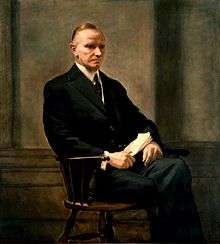Curtis D. Wilbur
| Curtis Dwight Wilbur | |
|---|---|
 | |
| Judge of the United States Court of Appeals for the Ninth Circuit | |
|
In office May 2, 1929 – May 10, 1945 | |
| Appointed by | Herbert Hoover |
| Preceded by | new seat |
| Succeeded by | William Edwin Orr |
| 43rd United States Secretary of the Navy | |
|
In office March 19, 1924 – March 4, 1929 | |
| President | Calvin Coolidge |
| Preceded by | Edwin Denby |
| Succeeded by | Charles F. Adams III |
| Personal details | |
| Born |
May 10, 1867 Boonesboro, Iowa |
| Died |
September 8, 1954 (aged 87) San Francisco, California |
| Political party | Republican |
| Spouse(s) | Olive Doolittle Wilbur |
| Profession | Politician, Lawyer, Judge |
| Religion | Congregationalist |
Curtis Dwight Wilbur (May 10, 1867 – September 8, 1954) was an American lawyer and official. He was appointed to the United States Naval Academy in 1884. Shortly after graduation, Curtis Wilbur resigned his commission, a common practice at the time, and moved to Riverside, California. He was admitted to the California bar in 1890 and served as Los Angeles Deputy Assistant District Attorney. Curtis Wilbur moved to the Superior Court in 1903, and finally, in 1918, to the California Supreme Court where he served as the 19th Chief Justice of California. Curtis Wilbur lived with his wife and children in a grand home completed in 1904 on Frederick Knob in San Francisco.
Biography
Wilbur was born in Boonesboro, Iowa.[1] On March 19, 1924, Curtis Wilbur was sworn in as Secretary of the Navy. The first appointee of President Calvin Coolidge, Curtis Wilbur came into the position with a reputation as a man of high intellect and a character of "unimpeachable integrity."
By the end of his term, Curtis Wilbur had achieved success in enlarging and modernizing the fleet and established a naval air force which would grow to become a potent component in the war with Japan.
In the last hours of his presidency, Coolidge nominated Curtis Wilbur to the Ninth Circuit Court of Appeals in San Francisco.[2] However, when the 70th Congress ended that week, the Senate had not acted on the nomination, so it expired.[3] President Herbert Hoover then resubmitted the nomination to the Senate in the 71st Congress, which approved it. Wilbur served as a judge in active service until 1945 when his senior status began.
In the 1930s, one of his children, Dr. Leonard Wilbur, established a mission hospital in the province of northern China now known as Shanxi. Leonard, his wife (Jean Spaulding) and two children (Ruth and Lyman) survived invasions by Chinese communist insurgents and Japanese troops. However, on Easter Sunday 1940, Leonard died in Shanxi of typhus. His wife later gave birth to their third child, Bruce, before departing China for San Francisco.
Following retirement, Curtis Wilbur spent time with his wife, the former Olive Doolittle, and their three surviving children (Edna, Paul and Lyman Dwight). He died in 1954.
 Curtis Dwight Wilbur and his family.
Curtis Dwight Wilbur and his family.
Legacy
The guided missile destroyer USS Curtis Wilbur (DDG-54) is named for him.
His brother Ray Lyman Wilbur was United States Secretary of the Interior under Herbert Hoover and a president of Stanford University.
References
- ↑
- ↑ "Wilbur Nominated for Judge Post," Woodland Daily Democrat, 1929-03-01 at p. 1 (noting, as the Coolidge Administration ended, that Coolidge nominated Wilbur for the new judgeship).
- ↑ "Sentence Cut Out by Hoover," Oakland Tribune, 1929-03-04, Section D, p. 1 (noting that the Wilbur nomination was not acted upon before the 70th Congress ended).
External links
| Legal offices | ||
|---|---|---|
| Preceded by Lucien Shaw |
Chief Justice of California 1923 – 1924 |
Succeeded by Louis W. Myers |
| Preceded by New seat |
Judge of the U.S. Court of Appeals for the Ninth Circuit 1929 – 1945 |
Succeeded by William E. Orr |
| Government offices | ||
| Preceded by Edwin Denby |
United States Secretary of the Navy 1924 – 1929 |
Succeeded by Charles F. Adams III |



